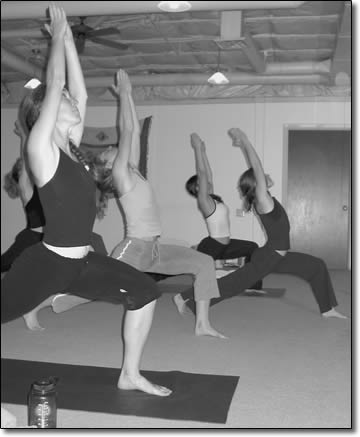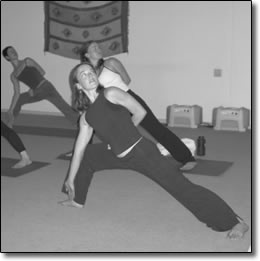
|
|
The women of the Durango Yoga Center, front to back, Erin Treat, Kim Self, Julia
Fisher and
Gretchen Hepburn execute a crescent lunge during a Dynamic Vinyasa, aka hot yoga
class, at
the center./Photo by Todd Thompson. |
C hange has always come slowly in the
long history of the practice of yoga, the origins of which date
back some 5,000 years ago to southern India. At least that was the
case for the first 4,950 years. Growing popularity in the Western
world has made yoga peculiarly reflective of the Western mind a
splintering of schools, leaders and followers, an unruly upstart
guru, and the lawsuits and bitter recriminations that
follow. In February 2002, the
Durango Yoga Center was founded in the Bikram tradition. That's as
in Bikram Choudhury, self-proclaimed yoga guru to the stars, yes,
Madonna, Raquel Welch and Serena Williams. The studio brought to
Durango a big city franchise of what was supposedly a unique
concept: yoga in a heated room. Hot Yoga. 104 degrees. Bikram Yoga.
Copyright claimed. The Durango Yoga Center
immediately developed a small but passionate following. Hot Yoga
was catching on, and the local community of athletes was trying it.
But when the founder and only Bikram-certified teacher, Kim
Carmichael, had to leave Durango, the future of the studio was
uncertain. It closed briefly last summer, but was revived by Elise
Fabricant who introduced a different style of yoga but kept the
heated room. With Bikram threatening to sue unauthorized users of
the Bikram name, it was obviously prudent to drop the
affiliation. But the concept remained
the same: heat and humidify a room for 90 minutes and perform a
yoga that consists of a fairly rapid flow of poses. Think of Bikram
as just an extra-hot variant of ashtanga or power yoga. The fitness
rationale for recreating the environment of southern India on a
warm day is provided, even if it is medically murky: Cold muscles
can't use fatty acids released during exercise, so the fat goes to
line your arteries instead. Hot muscles burn fat more efficiently.
The heat also loosens the muscles to increase the stretch. The
stretch releases stored toxins. The poses and the movement between
poses stimulate the systems: lymphatic, digestive, circulatory. And
the sweat and the systems take the toxins and fat away. Sounds like
most exercise. But it's yoga. There's
supposed to be something about the mind in there. Bikram is famous
for spewing expletives at his practitioners and forcing them to
endure the heat or be banished. This sort of boot camp mentality
was for many the final straw in the yoga wars. There had to be a
better balance between the physical and the meditative.

|
Halfway between flying and falling over, the half
moon pose is more stable than it looks as it is
demonstrated by, front to back, Julia Fisher,
Gretchen Hepburn and Rebecca Cotera./Photo by
Todd Thompson. |
On June 1, the Durango
Yoga Center enjoyed a second rebirth, under the new ownership of
Gretchen Hepburn. A two-year resident of Durango, Hepburn has
taught aerobics and group fitness for 12 years and has been
practicing yoga for seven years. She is enthusiastic about the
prospects for the studio, has already attracted new teachers and
expanded the summer schedule.
"The community has
really come together for the Yoga Center," Hepburn said recently.
"I feel the energy has expanded."
But the schedule remains
true to its roots, with its daily or twice daily dose of Hot Yoga,
now known formally as "Dynamic Vinyasa Yoga, a style integrating
Ashtanga, Bikram and Power yoga."
A few months ago using
the word Bikram on your flyer would have gotten the power guru's
legal machinery hopping mad. The brand has issued frequent and
threatening cease-and-desist orders to small studios for years and
recently settled its first lawsuit out of court to its
satisfaction. In response to the continuing threat of litigation, a
small group of teachers and studios founded the nonprofit
collective "Open Source Yoga Unity" to sue Bikram in federal court
for legal clarification of the question: a style of yoga be
copyrighted?"
Elizabeth Rader, a
copyright lawyer and a fellow at Stanford University, is
representing Open Source Yoga Unity. She said in a February
interview: "We're not disputing that Choudhury did something
creative and useful in putting the postures together in a certain
order. Our belief is that you can't treat the poses as private
property. Right now, people are trying to teach yoga but are not
sure what is going to get them sued."
The group won its first
legal victory on April 19 by defeating Bikram's motion to dismiss.
The judge found sufficient cause on the merits to hear the
question, without citing the similar Pilates copyright overturn of
2000, which was decided largely on brand abandonment
technicalities, not Bikram's weak suit. dismiss.
The judge found sufficient cause on the merits to hear the
question, without citing the similar Pilates copyright overturn of
2000, which was decided largely on brand abandonment
technicalities, not Bikram's weak suit.
A June 17 report in
The Economist roasted the Bikram franchise, calling
it the fast food of the yoga world. "At first, this
intellectual-property strategy seemed to be just another of
Bikram's wry jokes he argues that these asanas and pranayama
are like musical notes or dance steps public property to begin
with, but private property once 4 they
form part of a song or ballet." The article paraphrases Jim
Harrison, a lawyer for OSYU, as saying it's less like selling the
rights to a song and more like lecturing about the "Kama Sutra" and
then trying to charge couples a fee every time they have sex in one
of the positions.
That was when I decided I had to try hot yoga. Saturday morning,
9 a.m., I show up without a mat or a towel. I am welcomed anyway by
Dynamic Vinyasa instructor Julia Fisher. At least I brought water.
I sign a waiver indicating I am aware of the dangers of yoga I did
not know existed. Later I learn of widespread but anecdotal
indications of a "skyrocketing increase" in yoga-related
injuries.
I enter the room barefoot in shorts and a T-shirt. The hot air
is not the blast I expect, but it's warm alright, and I'm soon
sweating. Another newcomer feels the heat and leaves class. I find
the heat a pleasant sensation, like a damp sauna, like sweating
without working. Fisher enters the room, welcomes us again and has
us "om" three times together. For the next hour and a half, hers is
the only voice the 10 of us students hear, and it's a nonstop
gentle exhortation to keep moving between poses and to perform the
poses at the level we're comfortable with. There is a push to find
the strength within and a pull to be aware of our limits. Every
movement is choreographed with the breath, and there are reminders
to be aware of every sensation: "keep your buttocks engaged but
don't grip the tailbone, inhale, next exhale step or jump into
downward dog, push up from your hands and feet and out from your
center, inhale, next exhale push again and be aware of the weight
of your head, inhale, next exhale move into " for 90
minutes.
We move through the warm up (working a little, sweating a lot),
through the core strength and the balancing (really working, really
sweating) finally into the floor exercises, slowly "cooling" down.
I am a quiet damp puddle in the carpet. We om again and lie in
repose. After the movement and the stretching, the relief is truly
relaxing. My first thought when my mind starts chattering again is
"hey, that wasn't so bad!" Then I realize that my mind had stopped
chattering at all. "Hey, that was great!" I reluctantly leave the
heat and towel off, somewhat humbled by the transformation.
Some of the talk after class is a kind of reluctant appreciation
of the heat, almost as if the effects were too strong. Instructor
Fisher talks me through my frothy post practice. "You may find
yourself overwhelmed now from the effects of the heat," she says.
"It's not for everyone. I actually prefer a cooler practice in the
summer and a warmer practice in the winter."
Hatha teacher Rebeca Cotera says, "I don't mind the hot yoga,
but I prefer a cooler more restorative practice. I'm glad we're
offering a variety of styles with different levels of
meditation."
Student Sally Kondziolka has been with the Yoga Center from the
beginning. She loves the heat. "I prefer it a little hotter.
Actually I like it very hot. It's amazing how much you can stretch
safely in the heat. Your muscles become so pliable. You can get to
the inside, the core, of your structure."
Dusty Bender, a hot yoga student until he suffered a knee injury
while skiing, says, "I love the heat. It adds something to feel the
heat and sweat that much. It's a crazy good workout. It's amazing
how the posturing carries over into all these other sports. It's a
very beneficial routine. As the other sports change through the
season, you can keep doing the yoga and always benefit. I like the
series they do now more than the Bikram."
Owner Hepburn agrees that variety is important. "Each practice
peels away different layers of the mind, the body and the spirit.
Everyone will have different needs and different results. But at
the Durango Yoga Center the community can come together in health.
Having a healing center has been a dream of mine for a long time.
And that's what we're starting to create here." •
|